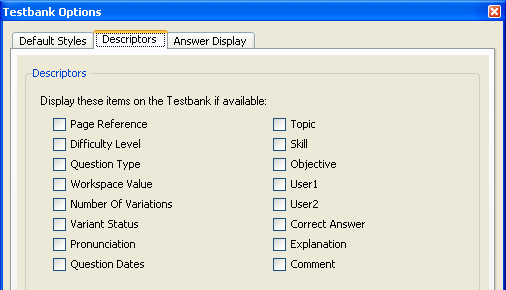
The first time you open a testbank, the display shows questions and information as it was set up by the testbank author—usually questions, answers, and applicable descriptors. To change the display of answers and descriptors in a testbank, you need to open the testbank for editing and change the descriptor display options.
Select the title of the testbank you want to change and select "Edit Testbank" from the File menu. (Testbank editing must be enabled for you to make changes in the descriptor display options.) This opens the testbank in the testbank editing window. Click in the testbank editing window and then select "Preferences > Testbank Options" from the Tools menu.
When the Testbank Options window opens, click the Descriptors tab, which contains controls to display or hide various testbank question descriptors while viewing a testbank in Question view or ID view.

Check the box for each descriptor you want to view in the current testbank. After making your selections, click OK to close the window. The selected descriptors show for each question in the testbank.
Note: Not all testbanks and question types contain information for all the descriptor categories, so only the descriptor label will show if a question has no assigned value for the selected descriptor category.
When you finish the testbank editing session and next view the testbank in the Testbank Library, it shows the descriptors you selected.
The descriptor fields are as follows:
Page Reference—Page references refer to a page, set of pages, or feature in the textbook related to the question.
Difficulty Level—A number from 1 to 9 indicates the relative difficulty of the question, ranging from easy to difficult. The numbers 1, 2, and 3 are most often used to denote easy, medium, and difficult questions. A difficulty of blank or 0 means that no difficulty level has been assigned by the author.
Question Type—The question type is indicated by an abbreviation for the main types of questions in TestGen: multiple choice (MC), bimodal (BI), true/false (TF), short answer (SA), essay (ES), matching (MA), and vocabulary (VO).
Workspace Value—A number from 0 to 15 indicates the number of blank lines that will show below the question if workspace is displayed on a test.
Number of Variations—The number of variations (Var:) tells how many variations are available for the question. If the question does not include any variables, then Var: is 1. When variables are included in the question, the number of variations can range anywhere from 1 to 50+ (more than 50), depending on the number of variables and the range for each variable.
Variant Status—When you check the Variant Status box, a downward pointing arrowhead (v) appears next to questions that contain variables and have more than one variation.
Pronunciation—Vocabulary (VO) questions can include a pronunciation to show a phonetic spelling of the term. This field does not display in ID view.
Question Dates—TestGen stores and displays the date a question was created and modified. The dates cannot be edited.
Topic, Skill, Objective—These three categories are shared fields that contain the topic, skill, or objective for a question. The category names and type of content vary from testbank to testbank and can be edited in testbanks. Note: The names of these categories, as well as User 1 and User 2, may be different due to changes during testbank authoring.
User 1, User 2—These two categories are shared fields that assign additional information to a question; the category names and type of information vary from testbank to testbank and can be edited in testbanks.
Correct Answer—In Question view, shows the letter of the correct answer for a multiple-choice question, the word True or False for true/false questions, full answers for short answer or essay, the term or definition for vocabulary questions, the correct match for a matching question. Answers do not display in ID view.
Explanation—Explanations may be provided by the testbank author to explain the correct answer for multiple-choice, true/false, or short answer questions. Incorrect answer choices for multiple-choice questions may also have explanations. Explanations do not display in ID view.
Comment—Comments may be provided by the testbank author. Comments do not display in ID view.